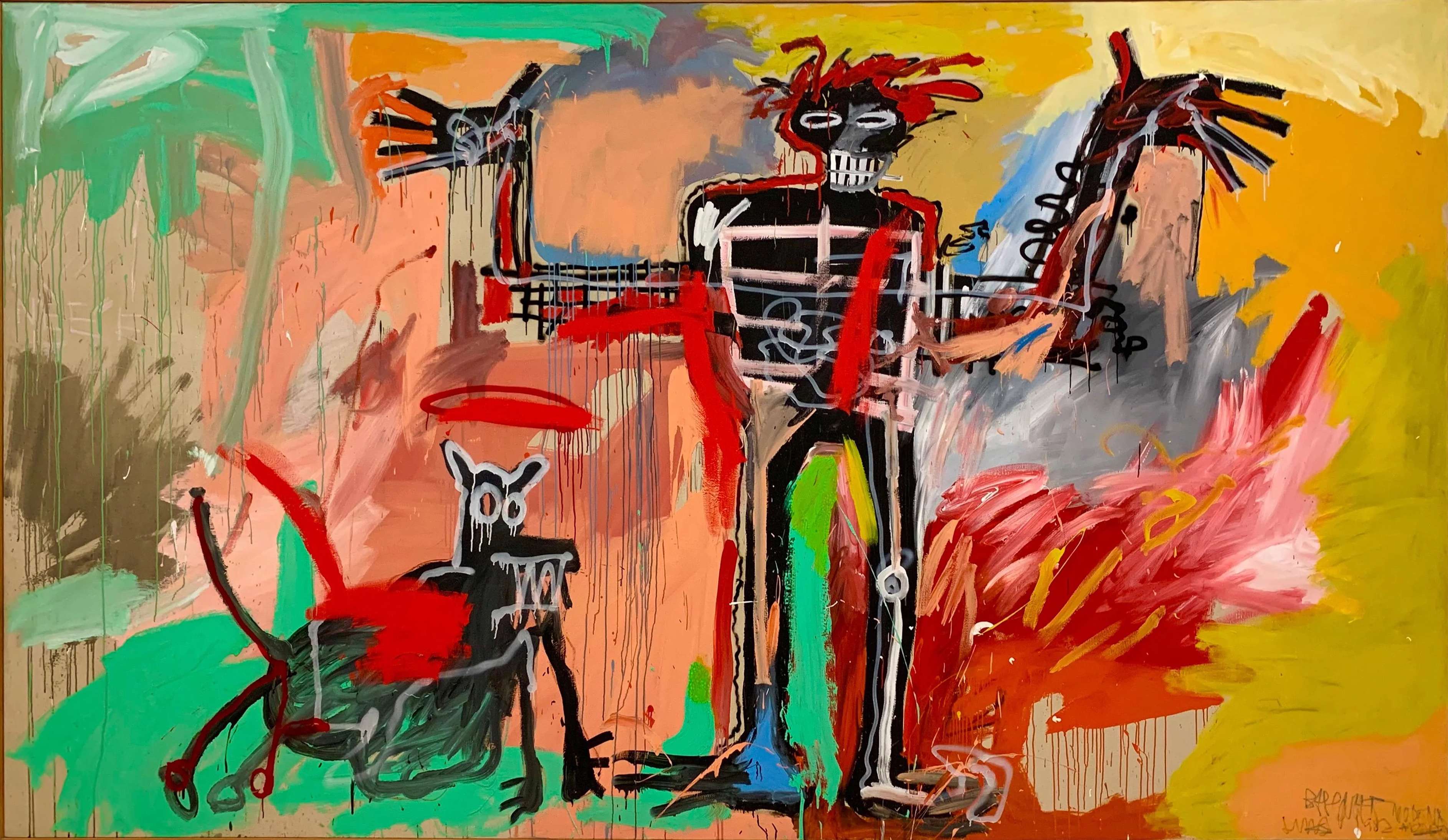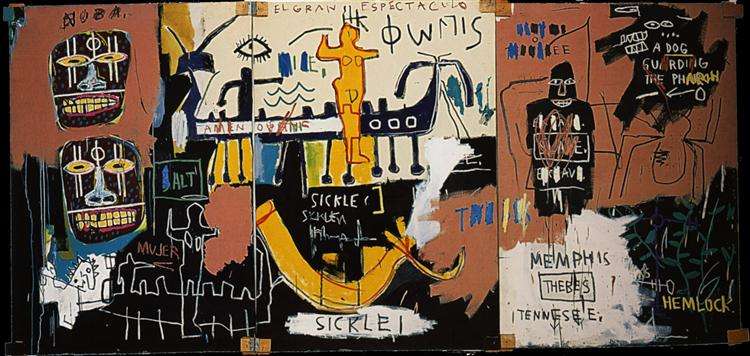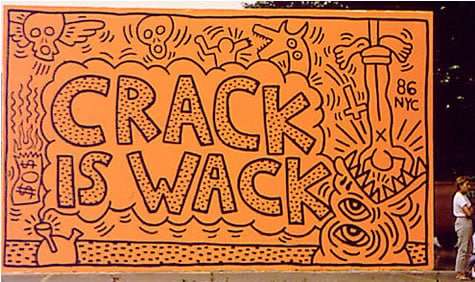The Relationship Between Art And Hip Hop Culture
Back in 2018, hip hop mogul Sean “Diddy” Combs made headlines after spending $21.1 million on Kerry James Marshall’s painting Past Times. The main reason this attracted so much attention? It was the most expensive piece of artwork in history to be sold by a living African-American artist.

However, this isn’t the only reason the purchase was such a landmark moment. It also highlighted the strength of the relationship between hip hop and art, with Diddy being the latest rap star to build a bridge between the two mediums. It wasn’t always this way, but after a lengthy and fascinating journey, art has become a central part of hip hop culture as we know it.

The Nile, 1983 – Jean-Michel Basquiat
Street Art In Hip Hop’s Early Days
In its infancy, hip hop was largely about marginalized groups using music to deliver messages regarding identity and empowerment, breaking the hegemony that corporations and governments had over public narratives. Hip hop has always had plenty in common with street art in this sense. Both were (and still are) mediums allowing individuals to communicate sociopolitical messages in a creative way. It is, therefore, no surprise that these two forms have crossed over a lot through the years.
Indeed, in the early days of rap music during the 1970s, it was rare to see a hip hop party, rap battle or performance without a street art backdrop. Whether graffiti covered the DJ booth or featured on buildings nearby, it created a stylized aesthetic that solidified the link between the two in the eyes of many, especially as many rappers were street artists too. This relationship was so strong that graffiti is commonly deemed one of the four elements of hip hop culture alongside deejaying (turntabling), rhyming (MCing) and B-boying (breakdancing).
The Merging Of Street Art And Fine Art
While hip hop and street art have always been closely associated, the same can’t be said about hip hop and fine art. However, this started to change in the late 70s and early 80s almost entirely thanks to a New York graffiti artist and rapper called Fab 5 Freddy.
Freddy was hell-bent on joining the city’s street art scene with the fine art world. First, he managed to secure his work and that of fellow graffiti artist Lee Quiñones in an Italian art exhibition in 1979. This is seen as a seminal moment in the genesis between hip hop and fine art, opening the doors for more urban artists to get their artwork seen in places other than the street. He then raised his profile further via significant appearances, including a cameo in the video for Blondie’s 1981 hit
Rapture, with Debbie Harry immortalizing the artist with the lyrics “Fab 5 Freddy told me everybody’s fly.” The year after, he produced and starred in the cult classic movie
Wild Style, a hip hop film centered around a graffiti artist who is invited to paint his art on canvas. This gave a huge boost to hip hop’s profile generally, let alone the genre’s role alongside art.

Image from The Keith Haring Foundation
Perhaps most importantly though, Freddy took artists including Jean-Michel Basquiat and Keith Haring under his wing and helped showcase their work to the world. These figures perfectly captured the aesthetics and sentiments of hip hop of the time, especially the sociopolitical issues afflicting black and Latino communities. Take Basquiat’s 1983 piece Untitled (History of the Black People), for example, which critiques the West’s understanding of history and its forgetfulness towards slavery. Or Haring’s Crack Is Wack mural in Harlem, lamenting New York’s crack epidemic during the mid-1980s. Getting these artists into the mainstream was key to the future relationship between hip hop and art, driving the interest of those within the rap community in artwork that really spoke to them on a personal level.
How Hip Hop Embraced Fine Art
Although the realms of hip hop and fine art began to intersect in the 80s, the relationship between the two still wasn’t as strong as it is now. This largely boiled down to the fact that rap’s culture was still embedded in the streets and often looked down upon by the upper echelons of the art industry. As such, it was hard for those in the hip hop community to truly rub shoulders with these individuals. But fast forward to the 90s, and things began to change.
Hip Hop Became A Commercial Genre
Although hip hop was popular in the 80s, it truly took off in the following decade as mainstream artists like the Notorious B.I.G., 2Pac, Snoop Dogg, Eminem and Nas began ruling the airwaves. By the end of the 90s, hip hop was the biggest-selling genre commercially, finally eschewing its perception as an underground genre. This meant many rappers with newfound fame found common ground with those in the fine art industry and had the means to make a splash in this world too.
Hip Hop Artists Became Art Collectors
Take hip hop producer Swizz Beatz, for instance, who became an art collector after being introduced to Peter Max’s work during a boat cruise in 1999. The New York Times has credited him with playing a crucial role in bridging hip hop and contemporary art by deejaying at art events, joining the board of the Brooklyn Museum, and launching his own art fair. He’s not the only hip hop artist to dip his toe into the fine art sphere though. The likes of Q-Tip, Jay-Z and Ja Rule are just three other high-profile names to become collectors, with Q-Tip’s collection including works by Richard Prince, Hassan Hajjaj and Fab 5 Freddy, for example. “Graduation” was released on September 11, 2007. Roc-A-Fella Records/UMG Recordings, Inc.
Hip Hop Stars Embraced Art In Their Own Work
Meanwhile, hip hop artists including Jay-Z, Pharrell Williams and Kanye West have also helped to unite hip hop and fine art through their own musical ventures. Take Jay-Z, who has not only regularly rapped about artists including Andy Warhol, Mark Rothko, Pablo Picasso, and Jeff Koons, but filmed his Picasso Baby music video at the Pace Gallery in New York City as part of a six-hour performance. While Pharrell interviewed creatives in his 2015 YouTube series called “ARTST TLK”, and West commissioned the likes of Takashi Murakami, George Condo and Peter De Potter to design his album artwork.
It’s no surprise that rap legend Diddy was the one to create history with his Past Times purchase, in yet another example of the realms of fine art and hip hop intersecting. The two mediums are now more intertwined than ever before, and it will be exciting to see how this relationship develops further in the future.